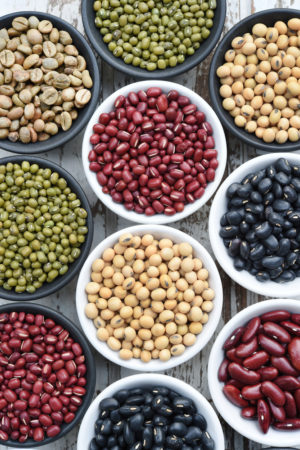All About Beans
by Robin Russell
Beans, defined.
Beans are “the edible seed or young seed pod of leguminous plants”. Included also in the legume family are lentils, peas and peanuts. Dried legumes are called pulses.

What’s good about beans?
While each variety of bean, pea or lentil has its own unique nutritional value, in general they are the richest source of vegetable protein and are a good source of both soluble and insoluble dietary fibre. When complemented with grains, nuts or seeds, a complete protein can be formed which can suitably replace meat, fish, poultry, eggs or dairy at the dinner table. Legumes offer a low-fat protein alternative to animal products, though soybeans and especially peanuts are higher in fat than the other varieties.
In addition to their protein and fibre contributions, beans are rich in calcium, thiamin, riboflavin, niacin, and several protective phytochemicals; they also provide some iron, molybdenum, manganese, zinc and carotene. Sprouted legumes have the additional benefit of being rich in vitamin C. Beans are an important part of many special diets such as gluten-free, low-sodium, low-fat, low-cholesterol, high fibre and diabetic.
Bean Dos and Don’ts
DO:
- store pulses in a cool, dry place;
- lightly rinse packaged pulses;
- sort bulk pulses and remove any pebbles, seed pods, leaves or twigs;
- soak your beans- it reduces cooking time by about one half, and saves vitamins, minerals and proteins which can be lost during prolonged heating — exceptions are lentils, split peas and black-eyed peas which may be cooked from their dry state;
- soak beans in plenty of water- use a 3:1 or 4:1 ratio of water to beans (see chart for soaking times).
DON’T:
- store pulses in the refrigerator;
- add baking soda to hasten soaking or cooking time as it will decrease the nutritional content of the beans;
- add salt or any product high in calcium, magnesium or acid to the soaking or cooking water or beans will not soften (products with these elements should be added to cooking water or any recipe calling for partially cooked beans only after beans have reached desired tenderness);
- use microwave to cook dry beans – microwaving is fine for reheating beans that are already cooked, but dry beans need to be simmered slowly in lots of water to soften, tenderize and rehydrate properly.